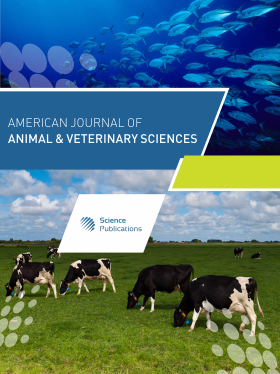Mixed Species Grazing of Cattle and Goats on Gastrointestinal Infections of Haemonchus Contortus
- 1 Southern University Agricultural Research and Extension Center, United States
- 2 Southern University and A and M College, United States
Abstract
At the present time, the meat of goat is the fastest growing class of livestock in the U.S.A. Due to the sub-tropical climate in the South Eastern region of the US, internal parasites pose a major constraint to the industry. The blood-feeding nematode, Haemonchus contortus results in production losses and even death in untreated animals. The control of H. contortus calls for the use of a combination of different control methods/strategies. An experiment was conducted over three successive years (2008, 2009 and 2010) to evaluate the effects of mixed species grazing on fecal egg counts (FEC in epg), FAMACHA© scores (FS) and Packed Cell Volume (% PCV) in goats. In a 2×2 factorial, 50 Spanish does and 14 Brangus cows were randomly assigned to continuous or rotational grazing systems. Goats were allowed to graze alone or mixed with cattle. The rotational pastures were divided into four paddocks and each paddock was grazed for 7d and allowed to rest for 21d. Every 28d Body Weight (BW), body condition scores (BCS; 1 = thin and 5 = fat), FS (1 = red and 5 = white), blood and feces were collected. Fecal and blood samples were analyzed in the lab for FEC and %PCV. Data was statistically analyzed using SAS’s MIXED and correlation coefficients were determined among the measurements. Overall means for PCV, FEC, BCS and FS were 27.4%, 613 epg, 2.3 and 2.5, respectively. PCV was negatively correlated to FS (r = -0.35, p<0.001) and FEC (r = -0.16, p<0.005). BCS was negatively correlated to FS (r = -0.59, p<0.001) and FEC (r = -0.17, p<0.005), while FS and FEC were positive (r = 0.20, p<0.005). Except for the effect of month (p<0.05), no differences due to the main effects were observed and interaction effects were significant at only p<0.10. Goats grazing alone in continuous pastures had a higher PCV and FS scores (28.6% and 2.7, respectively) than goats in mixed rotational pastures (25% and 2.2). The percentages of does in mixed pastures falling in FS-1, FS-2 and FS-3 categories were higher (5.2 Vs 8.9%, 17.0 Vs 22.7% and 15.7 Vs 19.6%, respectively) than does grazing alone. Overall, mixed grazing of pastures with cattle and goats reduced FEC in goats therefore decreasing FAMACHA scores that resulted in increased PCV and BCS values. The present data suggest alternative approaches for suppression of parasite loads include some management practices such as pasture rotation, mixed livestock species grazing and selective deworming.
DOI: https://doi.org/10.3844/ajavsp.2012.61.66

- 6,877 Views
- 5,857 Downloads
- 16 Citations
Download
Keywords
- Gastrointestinal nematodes
- goats
- Haemoncus contortus
- fecal egg count
- mixed grazing
